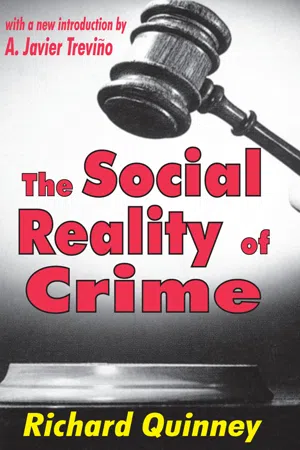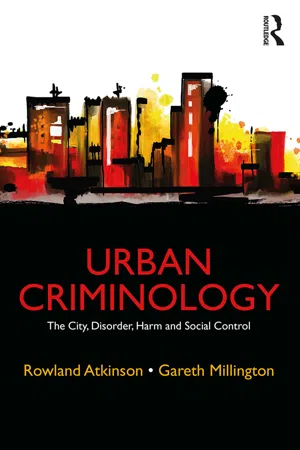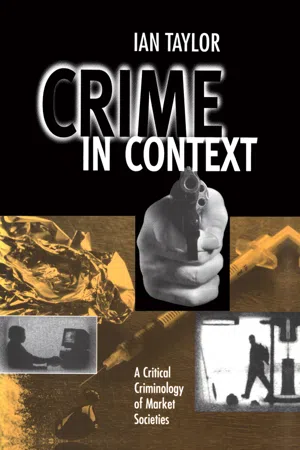History
Crime and Urbanization
The relationship between crime and urbanization refers to the impact of urban growth on crime rates. As cities expand, they often experience an increase in crime due to factors such as population density, social disorganization, and economic inequality. This phenomenon has been a subject of study in various historical periods, shedding light on the complex dynamics between urban development and criminal activity.
Written by Perlego with AI-assistance
Related key terms
4 Key excerpts on "Crime and Urbanization"
- eBook - ePub
- Wilhelm Roepke(Author)
- 2017(Publication Date)
- Routledge(Publisher)
33 Urban areas usually have higher rates for all major offenses, with the exception of murder. Hence, the greatest differences in rates between rural and urban areas are for crime against property, with the differences being less apparent for crimes against the person. The rates for all categories of offenses tend to increase progressively with each category of city size.Differences in offense rates between rural and urban areas can be accounted for by basic differences in the learning and opportunity structures of the two areas. In rural areas, as observed in several studies, there is a comparative absence of behavioral norms and social processes that are conducive to the development of behaviors that may be defined as criminal.34 Similarly, gang activity in rural areas is relatively limited. The possibilities for learning techniques and motivations for committing criminally defined activities are not as readily available in rural areas as in urban areas.Furthermore, opportunities for carrying out such property offenses as robbery, burglary, larceny, and auto theft are much greater in urban than in rural areas, and they become even more prevalent in large cities. In such ways, then, urban areas (especially the larger cities) provide the cultural and structural environments for the development of behavior patterns that may result in criminally defined activities.Variations Within Cities. Studies over several decades have documented fairly consistent patterns in crime and delinquency rates within the boundaries of American cities. Research by members of the “Chicago school,” in particular, established that the highest offense rates generally occur in the low rent areas near the center of the city and that the rates decrease with increasing distance from the city center.35 In addition, such studies have shown that the relative rates of crime and delinquency tend to be maintained within the respective areas of the city in spite of changes in the population of the areas.The distribution of offense rates tends to be related to social characteristics of areas within cities. From several sources we conclude that offense rates of areas are related to the economic, family, and racial composition of the areas. In Baltimore, it was found that delinquency rates of census tract areas were associated with the percentage of owner-occupied housing and the ratio of nonwhites to whites.36 Similar findings have emerged from studies of the distribution of offense rates in Washington, D.C., Detroit, and Indianapolis.37 Using somewhat different modes of analysis and theoretical assumptions, others have found similar variables to be related to the ecology of crime and delinquency in Seattle, San Diego, and Lexington, Kentucky.38 - eBook - ePub
Criminality and Criminal Justice in Contemporary Poland
Sociopolitical Perspectives
- Konrad Buczkowski, Beata Czarnecka-Dzialuk, Witold Klaus, Anna Kossowska, Irena Rzepli?ska, Dagmara Wo?niakowska-Fajst, Dobrochna Wójcik(Authors)
- 2016(Publication Date)
- Routledge(Publisher)
Chapter 3Social Change and Criminality: Mutual Relationships, Determinants and Implications
Anna KossowskaIntroduction
The links between social changes and criminality and, although not always obvious, the processes and phenomena concealed behind these two ideas, have long been of interest to sociologists and criminologists. Against this backdrop, ‘criminality’ is most often taken to mean conduct defined as such in official registers (i.e. discourse on criminality is generally published). This may exclude a whole raft of relevant issues connected with the social perception of the dangers of actual crime, i.e. crime that now shows up in statistics and does not provoke a response from the state or its institutions. The concept of ‘social change’ finds application in the description of some very diverse social processes, both progressing on the macro level and observable at the level of local communities. We can discuss social change in its associations with criminality once we have analysed the effects of such events as wars, revolutions, peaceful regime changes, industrialisation, urbanisation and the economic situation. Mass migration, revolutions brought about by technological changes (and all their ramifications), demographic changes, lifestyle changes, the structure of the labour market, the way social functions are performed and the internationalisation of social problems often need to be considered in this context. To all this can be added changes taking place in social consciousness, such as attitudes towards social inequality (and to social organisation generally), the presence of risk in everyday life, ‘truths’ about criminality and how to control it, and cultural diversity. It seems impossible to cite a single commonly acknowledged and universal definition of social change. Piotr Sztompka lists a range of definitions that simultaneously apply in contemporary sociology and then proposes his own (Sztompka 2005). This is fairly general, but for that reason useful, in preliminary deliberations. - eBook - ePub
Urban Criminology
The City, Disorder, Harm and Social Control
- Rowland Atkinson, Gareth Millington(Authors)
- 2018(Publication Date)
- Routledge(Publisher)
In this chapter, we discuss the importance of the urban spaces in which people reside, since neighbourhoods are in many ways the fundamental social-physical building blocks of the city. The neighbourhood is arguably a core organising concept for how we understand the distribution of risks and patterns of crime, and it plays a crucial role in shaping wider perceptions of order and disorder in the city. Here we consider how policing and other policy projects result in spatialisations of the city and urban space that reinforce designations of safety and danger. Of course, these spatial processes have the secondary effect of denoting certain neighbourhoods (and their inhabitants) as problematic, triggering the social stigmatisation of populations in particular districts. Others, taking a social ecological perspective, have stressed that the agglomeration of certain features of urban life in a particular spatial area of the city results in ‘neighbourhood effects’, which may include crime. Our aim here is to consider the nature of urban neighbourhoods and their connection to wider urban systems and institutions.The chapter is structured as follows. Firstly, we consider how neighbourhoods or locales comprise the urban mosaic of a city, focusing on how this is always differentiated by factors such as class or race. Second, we offer a brief history of what may be understood as the early criminological ‘ecologies’, examining diverse analysts including Mayhew, Booth, Riis and Engels. Here we also consider historical accounts of the nineteenth century in Paris by Louis Chevalier. Third, we examine urban ecology ‘proper’ in the guise of the Chicago School of Sociology. In this section, the radical critique – inspired by Engels’ account of Manchester – of the ‘liberal’ tendencies of the urban ecologists is also discussed. In the fourth and fifth sections, those urban spaces most commonly associated with crime in the West – the ghetto – is analysed in some detail, taking in both theoretical explanations and ethnographic accounts. The final section of the chapter looks at more ironic, or postmodern, evocations of urban ecology that suggest that fear of crime, disorder or difference is now shaping the form of the city. The politics of dystopian accounts of the city such as these is also explored.Early criminological ‘ecologies’
The neighbourhood appears to do for criminology what a concept like the family does for sociology; it is an essential ‘holding’ concept without which wider notions of crime and its urban roots could not be constructed. The importance of the neighbourhood in understanding crime has roots in scholars as diverse as Charles Booth, Robert Park and Ernest Burgess, Amos Hawley and, more latterly, Robert Sampson, who all in various ways have attempted to make spatial sense of the city by prescribing a series of neighbourhood ‘types’ that are criminogenic or occupied by criminal classes of people. In general terms, the aim of understanding why particular forms of social concentration and housing degradation occur in cities and how these are linked with crime and disorder has a long history in the social sciences. The problem, however, has been a tendency to locate neighbourhood conditions while paying less attention to the urban histories and their political economic contexts. These background forces are critical to the production of the kinds of socially deprived, traumatising or generally deficient spaces that have been associated with local deviant cultures or more serious forms of criminality. - eBook - ePub
Crime in Context
A Critical Criminology of Market Societies
- Ian Taylor(Author)
- 2013(Publication Date)
- Polity(Publisher)
4CRIME IN THE CITY: HOUSING AND CONSUMER MARKETS AND THE SOCIAL GEOGRAPHY OF CRIME AND ANXIETY IN MARKET SOCIETYIMAGES OF CRIME, IMAGES OF THE CITYThe bulk of the crime and disorder that is the source of so much anxiety in market societies occurs, as a matter of personal experience or, more often, as a matter of report, in public space within cities.1 This common sense connection has, of course, been in place, in the popular imagination, ever since the onset of mass industrialization and the explosive growth of the industrial cities in the nineteenth century (though it is worth remembering that the introduction of the ‘nightwatchman’ in English towns (and, indeed, of the jury system – understood as a group of witnesses to crime) dates from the Statute of Winchester in 1283 (Hibbert 1963: 27–9)). In Europe as a whole, from the early nineteenth century onwards, the ‘image of crime’ in the popular mind has been closely bound up with more or less dystopian images of the city itself as a place of threat or fear (Walkowitz 1992) – images that have been elaborated over the last 200 years, in a range of different ways, in crime fiction as well as in cinematic representations. Talking about crime in the late twentieth century is difficult to separate out from discussion of the condition of the city – and, indeed, throughout the last fifty years, during the high-point of the Fordist period, much of the criminological literature has overlapped with the literature of urban studies, and particularly with urban sociology.In the literature on the city produced in the English-speaking world, in particular, there has been a consistent and recurring interest in the experience of one American city, Chicago, especially during the period between 1860 and 1920 – a period of explosive population growth (a sixfold increase) and also, of course, a period of enormous expansion in the geographical spread of that city and the mix and diversity of its housing areas. One important objective in this chapter, however, is to suggest that this continuing reference to one North American city whose origins and rapid growth can all be dated to the last 150 years (and understood as an expression of the explosive growth of American capitalism in that period) may be a misleading framework for the overall, comparative analysis of the urban condition and, in particular, the new struggle for position between cities in various ways in different parts of the world that is a defining feature of the transnational market society.
Learn about this page
Index pages curate the most relevant extracts from our library of academic textbooks. They’ve been created using an in-house natural language model (NLM), each adding context and meaning to key research topics.



